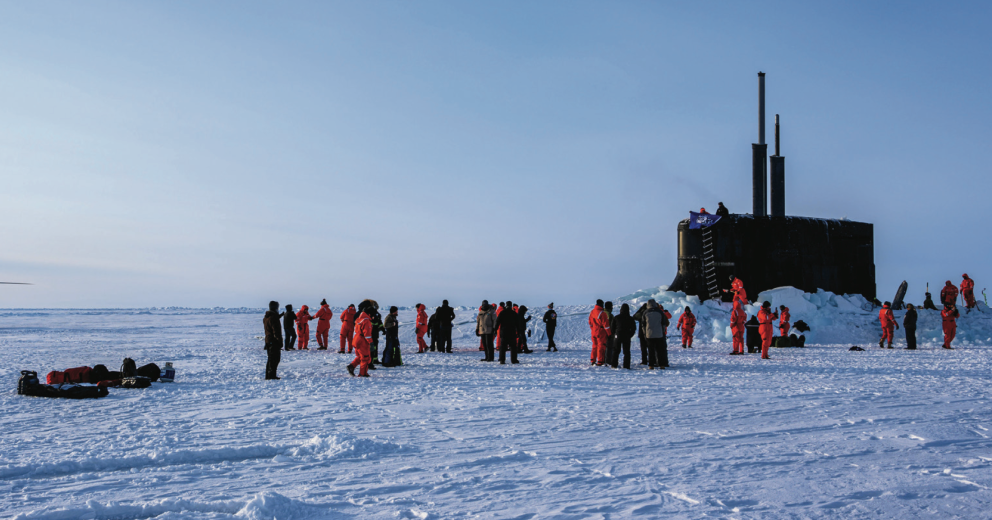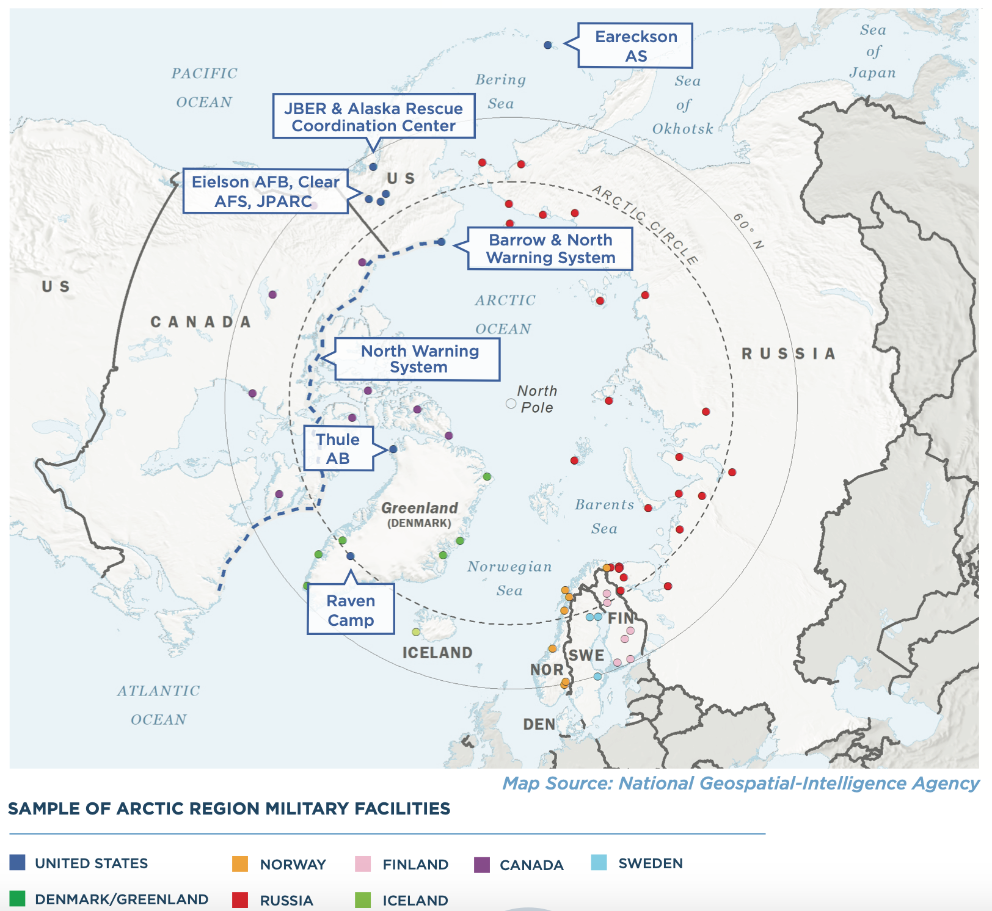Prepare to project "credible combat power" in the new era of "strategic competition".
If the Arctic was an important stage in the Cold War, in the new geopolitical tension its progressive thawing even accentuates its strategic characteristics. In 2019, the US Defence department adapted its Arctic strategy to the new rivalry with Russia and China, and then it was up to the forces most involved in the region to implement it: in 2020 the Air Force presented its own document and in 2021 the Navy did so, also involving the Marine Corps and the Coast Guard. The guidelines seek to ensure the projection of "credible combat power".

The crew of the submarine USS Connecticut at the ICEX 2020 exercises [US Navy].
article / Pablo Sanz
The Arctic is important because of the untapped natural wealth contained in its subsoil (22% of the world's hydrocarbon deposits, or 90 billion barrels of oil) and because of its strategic position on the globe: the two great continental masses of Eurasia and America converge here. The opening of new maritime routes thanks to the progressive melting of the ice is not only a commercial advantage, but also makes it possible to act militarily more quickly in this and other scenarios.
Many countries are interested in promote cooperation and multilateralism in the region, and this is done from the committee Arctic; however, the complex security environment of the Arctic Circle has led the major powers to set strategies to defend their respective interests. In the case of the United States, the Defence department updated in June 2019 the Arctic strategy it had developed three years earlier, in order to bring it into line with the new approach that emerged with the 2017 National Security Strategy (NSS) and carried over into the 2018 National Defence Strategy (NDS), documents that leave behind the era of combating international terrorism and elevate the relationship with China and Russia to 'rivalry', in a new geopolitical status of 'strategic competition'.
The Pentagon's strategy for the Arctic was then fleshed out by the air force in its own report , presented in July 2020, and then by the navy in January 2021. Along the same general lines, these approaches framework are aimed at three objectives:
1) As an "Arctic nation", because of its sovereignty over Alaska, the United States must ensure security in its territory and prevent polar positions from threatening other parts of the country.
2) The United States seeks to establish and lead alliances and agreements in the Arctic in accordance with international law in order to maintain a stable status in the area.
3) The United States commits to preserving free navigation and overflight in the Arctic Circle, while limiting Russian and Chinese interference contrary to this general freedom of access and transit.
To achieve these objectives, the Pentagon has defined three mechanisms for action:
i) Raising awareness of the importance of the area: the ability of the Defence department to detect threats in the Arctic is a prerequisite for deterring or responding to activities of strategic competitors in the region.
ii) Enhance and promote operations in the Arctic: department Defence will improve the ability of its forces to operate in the Arctic through regular exercises and deployments to the region, both independently and with allies. Some exercises will be conducted within the NATO context while others will be bilateral or multilateral.
iii) Strengthen the rules-based order in the Arctic: department Defence will continue to work with US allies to maintain and strengthen the freedom of navigation and overflight regime. This will help deter aggressive acts in the area.
From the new NDS the Defence department states that the US military must be able to solve the main problem identified - the erosion of the competitive edge against China and Russia - by being able to "deter and, if necessary, defeat great power aggression". To do so, it must develop a force that is "more lethal, resilient, agile and ready", which in the Arctic region must achieve "credible deterrent power".
US military doctrine warns that the Arctic's character as a 'strategic buffer' is 'eroding', becoming 'a pathway of threat to national territory due to the advances of competing great powers'. It also 'hosts critical launching points for global power projection and increasingly accessible natural resources'. However, it warns that "the immediate possibility of conflict is leave".
Thus, in the context of implementing the national defence strategy, the Pentagon states that it will continue to prepare its units to ensure that the Arctic is a secure and stable region in which US national interests, regional security and the work joint efforts of the nations involved to address common problems are safeguarded.
The US Air Force and Navy documents outline supporting measures to ensure the ability to deter hostile actions in the Arctic by other regional competitors in the area, while prioritising a cooperative and continuous approach that preserves the rules by which the Arctic is governed.

Air and sea
Because the Gulf of Mexico current heads towards the European side of the Arctic, the North American side of the Arctic suffers even harsher environmental conditions, with less maritime infrastructure and land routes. As a result, the Air Force's role in the defence of this area is clearly greater, accounting for 80% of the resources the Pentagon devotes to the region.
Its operations are based at a number of locations. Six of these are in Alaska: the large airborne instructions at Elmendorf-Richardson and Eielson; the early missile notice facility at Clear and the missile defence radar at Eareckson; and other coordination, training and survival school sites. Two others are in Greenland: the Raven training range for LC-130 aircraft and the Thule early missile notice site. In Canada, it has a system of some fifty radars shared by NORAD (North American Air Defence Command).
The air force intends to improve these capabilities, as well as command, control, communications, intelligence, surveillance and reconnaissance (C3ISR) capabilities. It has also set goal to enhance refuelling conditions. Once the F-35 deployment at Eielson is complete, Alaska will host more advanced fighters than any other location in the world.
For its part, the US Navy is positioning itself around the concept of the "Blue Arctic", thus graphically expressing the progressive homologation with the rest of the world's oceans of what has historically been an impassable white cap. The navy envisages increasing its presence, both with manned ships and new unmanned vessels. In its strategy document, it warns that the research in new capabilities "may not be fully realised and integrated into the naval force for at least a decade".
The increased naval presence in the region will also be realised through increased operations already routinely conducted in the Arctic by the Second and Sixth Fleets and through synchronisation with the Marine Corps and Coast Guard based in Alaska. To ensure this operational augmentation, the Navy will undertake an upgrade of docking facilities and attendance for its ships.
The Navy document, which does not specify specific preparations, also does not include the Coast Guard's announced plans for a new fleet of icebreakers. There are currently only two in service and the plan is to build three medium and three heavy icebreakers by 2029.
In doing so, Washington is trying to counter the accelerated efforts of its closest competitors. In July 2020, department warned of growing interest in the Arctic from Russia and China, accusing them of engaging in "increasingly aggressive" competition and lamenting that those countries that want "peace, freedom and democracy", including the United States, have been "naïve".
Russia and China
Russia has the largest land mass and population within the Arctic Circle, a region from which Russia derives 25 per cent of its GDP. No other country has such a permanent military presence above the 66th parallel; no other nation has so many icebreaking ships, a fleet Moscow wants to increase with fourteen new vessels, one of them nuclear-powered.
Russia formed its joint strategic command of the Northern Fleet in December 2014. "Since then, Russia has gradually strengthened its presence by creating new Arctic units, refurbishing old infrastructure and airfields, and establishing new military instructions along the coast. There is also a concerted effort to establish a network of air and coastal defence missile systems, early notice radars, rescue centres and a variety of sensors," according to the US defence report strategic Arctic department . The US also warns that Russia is attempting to regulate maritime traffic in the Northern Route in ways that may exceed its authority under international law.
China, on the other hand, without being an Arctic nation (Mohe, its northernmost city is at the same latitude as Philadelphia or Dublin) wants to be a major player in the region. It is an observer country of the committee Arctic and claims a "near-Arctic nation" status that Washington does not recognise. In 2018 it produced the first white paper on its Arctic policy and has integrated this area into its New Silk Road initiative.
China's diplomatic, economic and scientific activities in the Arctic have grown exponentially in recent years. At the moment its operational presence is limited: it has one Ukrainian-built polar-capable icebreaker (the Xuelong; it has recently built the Xuelong 2), which has sailed in Arctic waters on operations that China describes as research expeditions.
 The opening of Arctic sea lanes is in China's interest, as it could shorten trade shipment times to Europe and reduce its dependence on flows through the particularly vulnerable Strait of Malacca.
The opening of Arctic sea lanes is in China's interest, as it could shorten trade shipment times to Europe and reduce its dependence on flows through the particularly vulnerable Strait of Malacca.
Lately, China has been engaging in increased diplomatic activities with the Nordic countries and has research stations in Iceland and Norway, as well as mining resources in Greenland. This highlights Beijing's growing interest in consolidating its presence in the Arctic despite its remoteness from the region.
Russia's great financial capacity also means that it is counting on China to develop energy and infrastructure projects in the region, such as a liquefied natural gas facility in Yamal. According to Frédéric Laserre, an expert on Arctic geopolitics at Laval University, Russia has no choice but to accept Chinese capital to build and develop the infrastructure needed to exploit the resources due to Western economic sanctions.